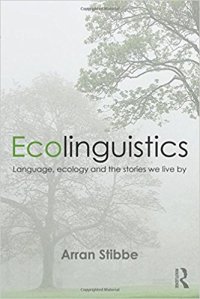Arran Stibbe – Ecolinguistics – review by Anthony Nanson
- Anthony Nanson

- Jul 7, 2019
- 3 min read
Updated: Apr 13

Arran Stibbe is the founder of the International Ecolinguistics Association. On this subject of ecolinguistics he, quite literally, wrote the book. The subject, and this superb book, is all about applying the tools of linguistics to the service of a better world.
Stibbe’s method is to analyse the language of texts, of many different kinds, to reveal the ‘stories we live by’. By ‘stories’ he doesn’t mean stories in the usual sense of narratives; he means, rather, the mental models that people carry – or, to put it more simply, beliefs. For example, analysis of economics textbooks uncovers the belief, or ‘story’, that ‘Consumers maximise their own satisfaction through purchase’. The ecolinguist then evaluates these ‘stories’ according to an ‘ecosophy’, a set of (ecological) values he or she has decided upon. The ecosophy Stibbe deploys in Ecolinguistics can be summed up as ‘Living!’ – which means valuing the flourishing of living organisms, including human beings. The particular ‘story’ I mentioned above, about consumers’ satisfaction, would fail to measure up to the requirements Stibbe spells out for this ‘Living!’ ecosophy.
The book examines in detail eight different categories of ‘stories’ (Stibbe acknowledges there are others he hasn’t covered). These categories are: ideologies and discourses; frames and framing; metaphors; evaluations and appraisal patterns; identities; convictions and facticity patterns; erasure; salience and re-minding. The texts he analyses under these headings are very varied, including not only textbooks, but journalism, advertising, broadcasting, policy documents, industry documents, political rhetoric, websites, and literature. His analysis is mainly of language, but does include the use of images too, for example by animal welfare campaigns.
Stibbe’s presentation of the relentless prevalence of many of the ‘stories’ he exposes is powerfully persuasive that they really are ‘stories we live by’; in other words, that the use of language in published texts really does influence, or even determine, what people believe and therefore what happens in the world. The book pre-dates the Brexit crisis, but it strikes me that Brexit is an excellent example of the way that the fostering, through rhetoric and journalism, of a set of beliefs can massively impact on our lives, irrespective of what the facts of the matter may be.
Very many of Stibbe’s examples reveal ‘stories’ that badly fail to satisfy his ecosophy, or probably any ecosophy that serves the common good. His own deadpan turn of phrase can make his skewering of the texts in question quite amusing. In his analysis of Men’s Health, for example, he writes that ‘if the cover states “Build a V Shape Back” or “ADD 3IN TO YOUR ARMS” then the reader is positioned as viewing these goals as desirable, whether or not they had previously thought that a V shaped back or enormous arms was a necessity in life’. The same directness can also be harrowing, as when he dissects documents from the poultry industry: ‘birds … “are slaughtered” … “are pasteurised” … “are transported” … “are hung upside-down” … “are shackled” … “are exposed to steam” … “are weighed individually” … “are inspected visually” … “are packed in plastic bags” … and “are sold” … This not only erases the birds as living, feeling, sensing beings, it also erases the human beings who are harming them.’
Although Ecolinguistics is marketed as an academic book, the simplicity of Stibbe’s style makes it accessible to any inquisitive reader. It should certainly be read by those involved in campaigns for the environment, animal rights, or social justice. But not just by them: I wish that everyone could acquire these skills to discern the values and assumptions embedded in the texts that make up our cultural landscape.
Texts from green campaigning groups, unsurprisingly, tend to fare better in meeting the requirements of Stibbe’s ecosophy. But the examples presented most affirmingly come from literary genres, in particular ‘New Nature Writing’ (books by the likes of Richard Mabey and Kathleen Jamie) and Japanese haiku, where language is used in more sophisticated ways to affirm the flourishing of nature.
I found Stibbe’s discussion of haiku the most uplifting part of the book, yet it seems to me that a whiff of the spirit of haiku pervades the whole book. Although the book is written with academic rigour, and addresses matters of such grave concern as climate change and factory farming, the honesty, lightness, and humanity of Stibbe’s prose make it a pleasure to read. These qualities are themselves an expression of a greatness of heart that ultimately underpins his work.




Comments